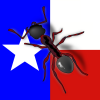1. Location: Katy, Texas
2. Date of collection: 6/22/17
3. Habitat of collection: My backyard spa, a grassy area surrounds it.
4. Length (from head to gaster): A little more than half a centimeter.
5. Color: Black or dark brown, with a striped abdomen. No visible hair.
6. Distinguishing characteristics: None.
7. Distinguishing behavior: Not too bothered by light so far.
8. Nest description: No nest description.
- Formiculture.com
- Forums
- Gallery
- Members
- Member Map
- Chat



















